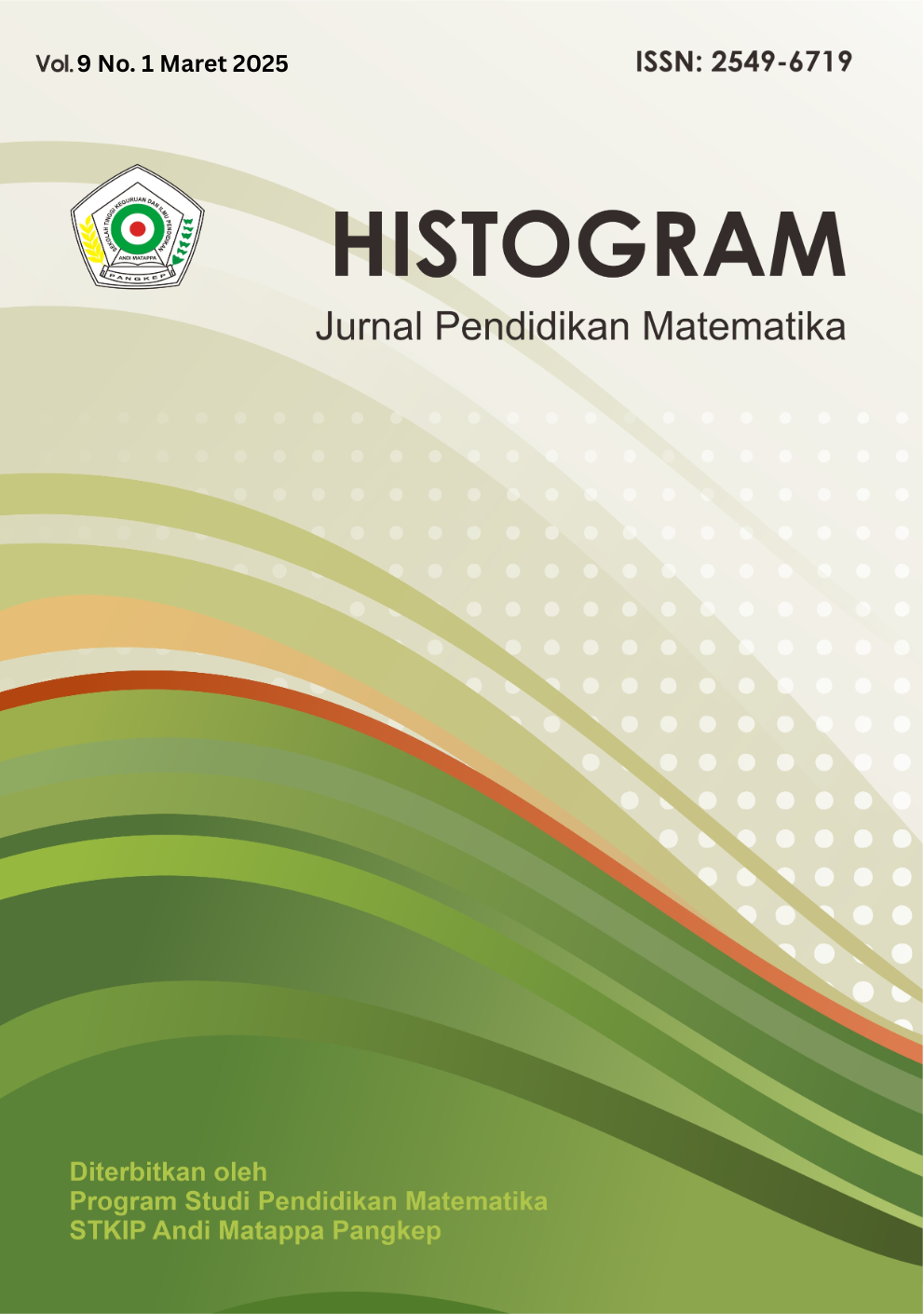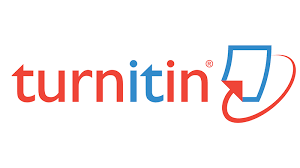PENGARUH FLIPPED CLASSROOM TERHADAP KEMAMPUAN KONEKSI MATEMATIS DAN MATH ANXIETY SISWA SMK
DOI:
https://doi.org/10.31100/histogram.v9i1.4166Kata Kunci:
Flipped Classroom, Kemampuan Koneksi Matematis, Math AnxietyAbstrak
ABSTRAK
Penelitian ini bertujuan untuk mengetahui pengaruh penerapan model pembelajaran kelas terbalik (flipped classroom) terhadap kecemasan matematika dan keterampilan koneksi matematis siswa. Penelitian ini menggunakan pendekatan kuantitatif dengan metode kuasi-eksperimen. Sebanyak 20 siswa kelas X TKJ di SMK Utama Bandar Lampung dipilih sebagai sampel penelitian. Instrumen yang digunakan berupa angket kecemasan matematika dan tes keterampilan koneksi matematis, yang kemudian dianalisis menggunakan uji statistik dengan taraf signifikansi 0,05. Hasil penelitian menunjukkan bahwa model kelas terbalik dapat menurunkan tingkat kecemasan matematika siswa, ditunjukkan oleh nilai signifikansi 0,776 (> 0,05), sehingga H0 diterima. Sementara itu, kemampuan koneksi matematis siswa menunjukkan perbedaan yang signifikan, dengan nilai signifikansi 0,124 dan hasil uji hipotesis yang menunjukkan penolakan H0. Selain itu, uji-F terhadap kedua variabel menghasilkan nilai signifikansi < 0,05 dengan selisih 0,02, yang menandakan adanya pengaruh simultan model kelas terbalik terhadap kecemasan matematika dan keterampilan koneksi matematis. Dengan demikian, penerapan model pembelajaran kelas terbalik berpengaruh positif terhadap pengurangan kecemasan matematika serta peningkatan keterampilan koneksi matematis siswa pada mata pelajaran matematika.
ABSTRACT
This study aims to examine the effect of the flipped classroom learning model on students’ mathematics anxiety and mathematical connection skills. A quantitative approach with a quasi-experimental method was employed. The research involved 20 tenth-grade Computer Network Engineering students at SMK Utama Bandar Lampung as the sample. The instruments used included a mathematics anxiety questionnaire and a mathematical connection skills test, which were analyzed using statistical tests at a 0.05 significance level. The findings revealed that the flipped classroom model effectively reduced students’ mathematics anxiety, as indicated by a significance value of 0.776 (>0.05), leading to the acceptance of the null hypothesis (H0). Meanwhile, students’ mathematical connection skills showed significant improvement, with a significance value of 0.124 and hypothesis testing results indicating the rejection of the null hypothesis (H0). Furthermore, the F-test results for both variables showed a significance value below 0.05 with a difference of 0.02, indicating a simultaneous effect of the flipped classroom model on mathematics anxiety and mathematical connection skills. In conclusion, the implementation of the flipped classroom learning model positively impacts reducing mathematics anxiety and improving students’ mathematical connection skills in mathematics learning.
Referensi
Arifin, S., Setiawan, Y. E., & Faradiba, S. S. (2022). Profil Kemampuan Koneksi Matematis Siswa Ditinjau dari Gaya Belajar. Histogram: Jurnal Pendidikan Matematika, 6(2), 349–360. https://doi.org/10.31100/histogram.v6i2.2430
Candra, S. P., Ulfah, A. D., Lily, Y., Panatap, S. J., & Nuraeni, N. (2024). Konsep Penelitian Kuantitatif: Populasi, Sampel, dan Analisis Data (Sebuah Tinjauan Pustaka). Jurnal Ilmu Multidisiplin, 3(1), 1–12. https://doi.org/10.38035/jim.v3i1
Chairul, F., Irvan, I., & Zainal, A. (2024). Pengaruh Model Pembelajaran Problem Based Learning dan Discovery Learning terhadap Kemampuan Koneksi Matematis Siswa. Journal Mathematics Education Sigma, 5(1), 36–46. https://doi.org/10.30596/jmes.v5i1.18579
Dzulfikar, A. (2016). Kecemasan Matematika pada Mahasiswa Calon Guru Matematika. Jurnal Matematika dan Pendidikan Matematika, 1(1). https://doi.org/10.26594/jmpm.v1i1.508
Erna, A., & Eka, L. K. (2022). Efektivitas Model Connected Mathematics Project terhadap Kemampuan Penalaran Matematis dan Kecemasan Matematika. Jurnal Educatio, 8(3), 873–882. https://doi.org/10.31949/educatio.v8i3.2305
Fauziah, A., & Ihsan, I. A. (2022). Kemampuan Pemecahan Masalah Matematis Pada Siswa SMK Ditinjau dari Kecemasan Matematika. Jurnal Educatio, 8(1), 236–246. https://doi.org/10.31949/educatio.v8i1.1973
Hasanah, H., Wirawati, S. M., & Sari, F. A. (2020). Pengembangan Bahan Ajar Matematika Berbasis STEM pada Materi Bangun Ruang. Indonesian Journal of Learning Education and Counseling, 3(1), 91–100.
Juniantari, M., Pujawan, I. G. N., & Widhiasih, I. D. A. G. (2018). Pengaruh Pendekatan Flipped Clasroom terhadap Pemahaman Konsep Matematika Siswa SMA. Journal of Education Technology, 2(4), 197–204. https://doi.org/10.23887/jet.v2i4.17855
Juniar, B. B., & Meiliasari, M. (2025). Systematic Literature Review: Model Pembelajaran untuk Meningkatkan Kemampuan Literasi Matematika Siswa. Jurnal PEKA (Pendidikan Matematika), 8(2), 70–79. https://doi.org/10.37150/jp.v8i2.3189
Mukhayat, A., Noer, S. H., & Sutiarso, S. (2024). Kemampuan Komunikasi dan Pemahaman Konsep Matematika melalui Model Flipped Classroom Berbantu Media Pembelajaran. Jurnal Inovasi Pendidikan Matematika, 6(2), 162–172. https://doi.org/10.31851/indiktika.v6i2.15034
Ningrum, H. U., Mulyono, M., Isnarto, I., & Wardono, W. (2019). Pentingnya Koneksi Matematika dan Self-Efficacy pada Pembelajaran Matematika SMA. PRISMA, Prosiding Seminar Nasional Matematika. https://journal.unnes.ac.id/sju/prisma/article/view/29237/12889
Nurul, A. R. (2016). Kecemasan Matematika dan Pemahaman Matematis. FORMATIF: Jurnal Ilmiah Pendidikan MIPA, 6(1), 12–22. https://doi.org/10.30998/formatif.v6i1.748
Rindaningsih, I. (2018). Efektifitas Model Flipped Classroom dalam Mata Kuliah Perencanaan Pembelajaran Prodi S1 PGMI UMSIDA. Icecrs International Consuortium of Education and Culture Research Studies, 1(3), 51–60. https://doi.org/10.21070/picecrs.v1i3.1380
Septian, A., Inayah, S., & Berliana, R. (2022). Implementasi Flipped Classroom terhadap Pemahaman Matematis dan Kemandirian Belajar Siswa. Jurnal Pendidikan Matematika, 4(1), 98–111. https://doi.org/10.32938/jpm.v4i1.2883
Setialaksana, W., Abdal, N. M., & Yusri, A. Y. (2021). Mediasi Gender pada Hubungan Kecemasan Matematika dan Hasil Belajar. Histogram: Jurnal PendidikanMatematika, 5(2), 83–92. https://doi.org/10.31100/histogram.v5i2.1394
Syarah, F. (2023). Pengaruh Model Pembelajaran Flipped Classroom terhadap Kemampuan Konsep Matematis. Jurnal Matematika dan Pendidikan Matematika, 6(2), 202–207. https://doi.org/10.47662/farabi.v6i2.649
Wihardjo, E., Karim, K., & Sukmawati, R. A. (2024). Transformasi Pendidikan Matematika di Era Digital: Efektivitas Model Kelas Terbaik. Journal of Mandalika Literature, 6(1), 109–118. https://doi.org/10.36312/jml.v6i1.3848
Unduhan
Diterbitkan
Terbitan
Bagian
Citation Check
Lisensi
Hak Cipta (c) 2025 Siti Soviah, Fungky Marian, Suryatul Aini Ashyar

Artikel ini berlisensi Creative Commons Attribution-NonCommercial-NoDerivatives 4.0 International License.
Please find the rights and licenses in Histogram: Jurnal Pendidikan Matematika. By submitting the article/manuscript, the author(s) accept this policy.
1. License
The non-commercial use of the article will be governed by the Creative Commons Attribution license as currently displayed on Creative Commons Attribution-ShareAlike 4.0 International.
2. Author's Warranties
The author warrants that the article is original, written by a stated author(s), has not been published before, contains no unlawful statements, does not infringe the rights of others, is subject to copyright that is vested exclusively in the author and free of any third party rights, and that any necessary written permissions to quote from other sources have been obtained by the author(s).
3. User Rights
Histogram: Jurnal Pendidikan Matematika's spirit is to disseminate articles published for free. Under the Creative Commons license, Histogram: Jurnal Pendidikan Matematika permits users to copy, distribute, display, and perform the work for non-commercial purposes only. Users will also need to attribute authors and Histogram: Jurnal Pendidikan Matematika when distributing works in the journal.
4. Rights of Authors
Authors retain all their rights to the published works, such as (but not limited to) the following rights;
- Copyright and other proprietary rights relating to the article, such as patent rights,
- The right to use the substance of the article in one's future works, including lectures and books,
- The right to reproduce the article for one's purposes,
- The right to self-archive the article,
- The right to enter into separate, additional contractual arrangements for the non-exclusive distribution of the article's published version (e.g., post it to an institutional repository or publish it in a book), with an acknowledgment of its initial publication in this journal (Histogram: Jurnal Pendidikan Matematika).
5. Co-Authorship
If other authors jointly prepared the article, any author submitting the manuscript warrants that all co-authors have authorized them to agree on this copyright and license notice (agreement) on their behalf and agree to inform their co-authors of the terms of this policy. Histogram: Jurnal Pendidikan Matematika will not be held liable for anything arising from the author(s) internal dispute. Histogram: Jurnal Pendidikan Matematika will only communicate with the corresponding author.
6. Royalties
This agreement entitles the author to no royalties or other fees. To such an extent that it is legally permissible, the author waives their right to collect royalties relative to the article regarding any use by Histogram: Jurnal Pendidikan Matematika.
7. Miscellaneous
Histogram: Jurnal Pendidikan Matematika will publish the article (or have it published) in the journal if the editorial process is completed. Histogram: Jurnal Pendidikan Matematika h editors may modify the article to a style of punctuation, spelling, capitalization, referencing, and usage that deems appropriate. The author acknowledges that the article may be published to be publicly accessible, and such access will be free of charge for the readers, as mentioned in point 3.





